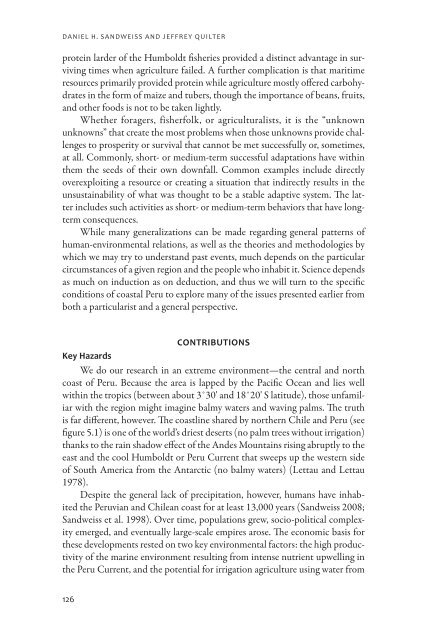free download - University Press of Colorado
free download - University Press of Colorado
free download - University Press of Colorado
You also want an ePaper? Increase the reach of your titles
YUMPU automatically turns print PDFs into web optimized ePapers that Google loves.
Daniel H. Sandweiss and Jeffrey Quilter<br />
protein larder <strong>of</strong> the Humboldt fisheries provided a distinct advantage in surviving<br />
times when agriculture failed. A further complication is that maritime<br />
resources primarily provided protein while agriculture mostly <strong>of</strong>fered carbohydrates<br />
in the form <strong>of</strong> maize and tubers, though the importance <strong>of</strong> beans, fruits,<br />
and other foods is not to be taken lightly.<br />
Whether foragers, fisherfolk, or agriculturalists, it is the “unknown<br />
un knowns” that create the most problems when those unknowns provide challenges<br />
to prosperity or survival that cannot be met successfully or, sometimes,<br />
at all. Commonly, short- or medium-term successful adaptations have within<br />
them the seeds <strong>of</strong> their own downfall. Common examples include directly<br />
overexploiting a resource or creating a situation that indirectly results in the<br />
unsustainability <strong>of</strong> what was thought to be a stable adaptive system. The latter<br />
includes such activities as short- or medium-term behaviors that have longterm<br />
consequences.<br />
While many generalizations can be made regarding general patterns <strong>of</strong><br />
human-environmental relations, as well as the theories and methodologies by<br />
which we may try to understand past events, much depends on the particular<br />
circumstances <strong>of</strong> a given region and the people who inhabit it. Science depends<br />
as much on induction as on deduction, and thus we will turn to the specific<br />
conditions <strong>of</strong> coastal Peru to explore many <strong>of</strong> the issues presented earlier from<br />
both a particularist and a general perspective.<br />
Contributions<br />
Key Hazards<br />
We do our research in an extreme environment—the central and north<br />
coast <strong>of</strong> Peru. Because the area is lapped by the Pacific Ocean and lies well<br />
within the tropics (between about 3˚30' and 18˚20' S latitude), those unfamiliar<br />
with the region might imagine balmy waters and waving palms. The truth<br />
is far different, however. The coastline shared by northern Chile and Peru (see<br />
figure 5.1) is one <strong>of</strong> the world’s driest deserts (no palm trees without irrigation)<br />
thanks to the rain shadow effect <strong>of</strong> the Andes Mountains rising abruptly to the<br />
east and the cool Humboldt or Peru Current that sweeps up the western side<br />
<strong>of</strong> South America from the Antarctic (no balmy waters) (Lettau and Lettau<br />
1978).<br />
Despite the general lack <strong>of</strong> precipitation, however, humans have inhabited<br />
the Peruvian and Chilean coast for at least 13,000 years (Sandweiss 2008;<br />
Sandweiss et al. 1998). Over time, populations grew, socio-political complexity<br />
emerged, and eventually large-scale empires arose. The economic basis for<br />
these developments rested on two key environmental factors: the high productivity<br />
<strong>of</strong> the marine environment resulting from intense nutrient upwelling in<br />
the Peru Current, and the potential for irrigation agriculture using water from<br />
126





